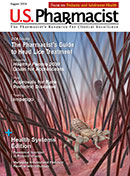The meta-analysis was conducted on behalf of the Lipid and Blood Pressure Meta-Analysis Collaboration and the International Lipid Expert Panel and was recently published online in the European Heart Journal. The authors performed a meta-analysis of several databases through May 31, 2021, for studies that reported the prevalence of SI.
The primary endpoint was overall prevalence and prevalence according to a range of diagnostic criteria (National Lipid Association [NLA], International Lipid Expert Panel [ILEP], and European Atherosclerosis Society [EAS]) and in different disease settings. The secondary endpoint was to identify possible risk factors for SI. A random-effects model was applied to estimate the overall pooled prevalence.
A total of 176 studies (112 randomized, controlled trials [RCTs]; 64 cohort studies) with 4,143,517 patients were included in the analysis. With a mean follow-up of 19 ± 7.3 months, the overall prevalence of SI was 9.1% (95% CI, 8.0%-10%). The prevalence was comparable when defined using NLA, ILEP, and EAS criteria (7.0% [6.0%-8.0%], 6.7% [5.0%-8.0%], 5.9% [4.0%-7.0%], respectively).
The prevalence of SI in RCTs was significantly lower compared with cohort studies (4.9% vs. 17%). The prevalence of SI in studies including both primary and secondary prevention patients was much higher than when primary or secondary prevention patients were analyzed separately.
Statin lipid solubility did not affect the prevalence of SI (4.0% [2.0%-5.0%] versus 5.0% [4.0%-6.0%]). Age (odds ratio [OR], 1.33; P = .04), female gender (OR, 1.47; P = .007), Asian and Black race (P >.05 for both), obesity (OR, 1.30; P = .02), diabetes mellitus (OR, 1.26; P = .02), hypothyroidism (OR, 1.37; P = .01), chronic liver, and renal failure (P <.05 for both) were significantly associated with SI in the meta-regression model. A greater risk of SI was linked with the use of antiarrhythmic agents, calcium channel blockers, alcohol use, and increased statin dose.
The researchers recognized some limitations to their meta-analysis, such as differences between patients included in different studies, and lack of information on the amount of alcohol consumption and types of exercise. However, they attempted to diminish the risk of bias from these, and this is aided by the large number of studies and patients included in the analysis.
The authors concluded that based on the present analysis of more than 4 million patients, the prevalence of SI is low when diagnosed according to international definitions. They also noted that these results support the concept that the prevalence of complete SI might often be overestimated and emphasize the need for the careful evaluation of patients with potential symptoms related to SI.
In a press release on the European Society of Cardiology website, Maciej Banach, MD, PhD, FNLA, FAHA, FESC, professor of cardiology and head of the Department of Hypertension at the Medical University of Lodz and head of the Cardiovascular Research Centre at the University of Zielona Gora, Poland, stated, "These results were not a surprise to me, but they were for many other experts. They show that in most cases statin intolerance is overestimated and over diagnosed, and they mean that around 93% of patients on statin therapy can be treated effectively, with very good tolerability and without any safety issues. Our findings mean that we should evaluate patients symptoms very carefully, firstly to see whether symptoms are indeed caused by statins, and secondly, to evaluate whether it might be patients perceptions that statins are harmful—so-called nocebo or drucebo effect—which could be responsible for more than 50% of all symptoms, rather than the drug itself."
Regarding the factors identified in the study that may increase risk of SI, Dr. Banach also stated, "It is critically important to know about these risk factors so that we can predict effectively that a particular patient is at higher risk of statin intolerance. Then we can consider upfront other ways to treat them in order to reduce the risk and improve adherence to treatment. This could include lower statin doses, combination therapy and use of innovative new drugs."
« Click here to return to Cardiology Update.





